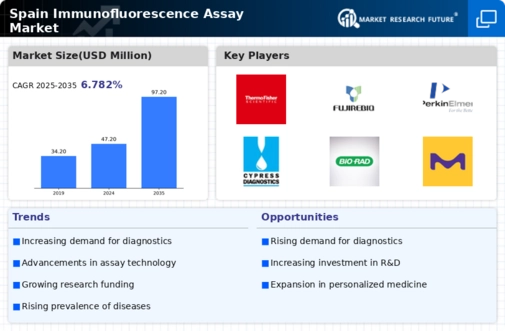Increasing Research Funding
The immunofluorescence assay market in Spain is experiencing a notable boost due to increasing research funding from both public and private sectors. Government initiatives aimed at enhancing healthcare research have led to a rise in financial support for laboratories and academic institutions. In 2025, funding for biomedical research in Spain is projected to reach approximately €1.5 billion, which is expected to significantly enhance the capabilities of research facilities. This influx of capital allows for the acquisition of advanced immunofluorescence technologies, thereby improving the quality and efficiency of assays. As a result, the market is likely to expand, driven by the demand for innovative diagnostic tools and research methodologies that utilize immunofluorescence techniques.
Expansion of Biopharmaceutical Sector
The expansion of the biopharmaceutical sector in Spain is emerging as a significant driver for the immunofluorescence assay market. With a growing number of biopharmaceutical companies focusing on drug development and personalized medicine, there is an increasing need for advanced diagnostic tools to support clinical trials and research. The biopharmaceutical market in Spain is projected to reach €10 billion by 2026, creating a robust demand for immunofluorescence assays that can facilitate biomarker discovery and validation. This trend indicates a promising future for the market, as collaborations between biopharmaceutical firms and diagnostic laboratories are likely to enhance the application of immunofluorescence techniques in drug development.
Growing Prevalence of Chronic Diseases
The rising incidence of chronic diseases in Spain is a critical driver for the immunofluorescence assay market. Conditions such as cancer, autoimmune disorders, and infectious diseases are becoming increasingly prevalent, necessitating advanced diagnostic tools for effective management. According to recent health statistics, chronic diseases account for over 70% of total healthcare costs in Spain. This trend underscores the urgent need for precise diagnostic methods, including immunofluorescence assays, which are known for their sensitivity and specificity. Consequently, healthcare providers are likely to invest more in these assays to enhance patient outcomes, thereby propelling market growth.
Advancements in Diagnostic Technologies
Technological innovations in diagnostic methodologies are significantly influencing the immunofluorescence assay market. The introduction of automated systems and high-throughput screening technologies has streamlined the assay process, making it more efficient and reliable. In Spain, the market for diagnostic equipment is expected to grow at a CAGR of 8% through 2025, driven by these advancements. Enhanced imaging techniques and the development of multiplex assays are also contributing to the increased adoption of immunofluorescence assays in clinical laboratories. As these technologies evolve, they are likely to improve diagnostic accuracy and reduce turnaround times, further stimulating market demand.
Rising Awareness of Early Disease Detection
There is a growing awareness among healthcare professionals and the general public regarding the importance of early disease detection, which is positively impacting the immunofluorescence assay market. Educational campaigns and initiatives by health organizations in Spain are emphasizing the benefits of early diagnosis in improving treatment outcomes. This heightened awareness is leading to increased utilization of immunofluorescence assays, particularly in oncology and infectious disease diagnostics. As more healthcare providers adopt these assays as part of routine testing protocols, the market is expected to witness substantial growth, driven by the demand for reliable and rapid diagnostic solutions.



















Leave a Comment